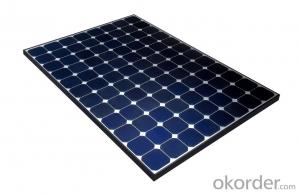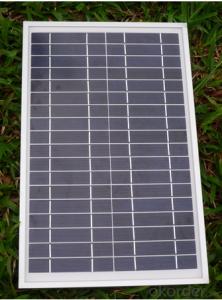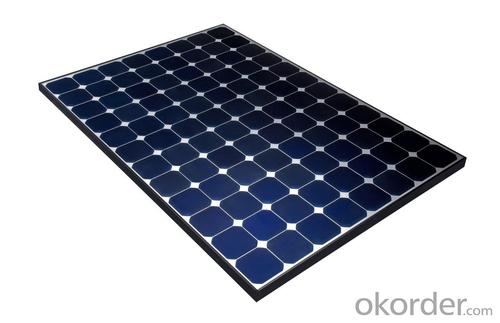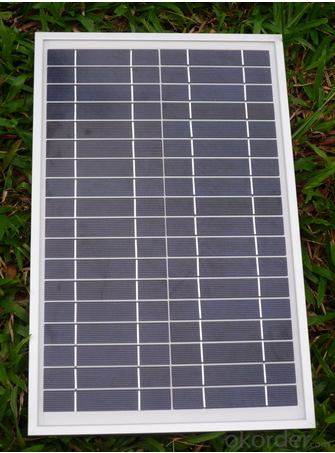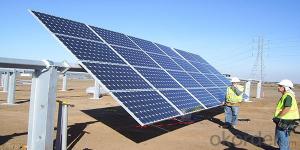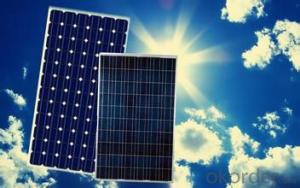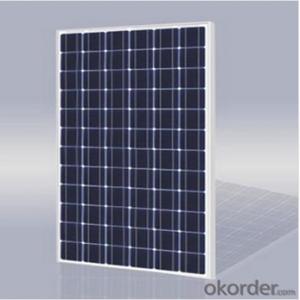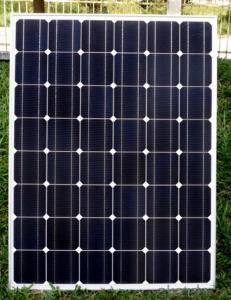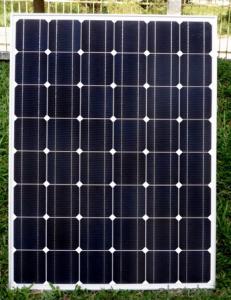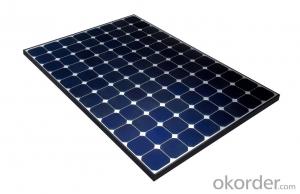110kw CNBM Monocrystalline Silicon Solar Energy Systems Panel for Home Use
- Loading Port:
- Tianjin
- Payment Terms:
- TT OR LC
- Min Order Qty:
- 10 watt
- Supply Capability:
- 1000 watt/month
OKorder Service Pledge
OKorder Financial Service
You Might Also Like
Specification
110KW CNBM Monocrystalline Silicon Panel for Home Using
Production description
On 13 April 2006, USA Today reported that there were "some 180,000 families living off-grid, a figure that has jumped 33% a year for a decade," and cited Richard Perez, publisher of Home Power Magazine,[6] as the source.[7] Assuming the same rate of growth, there would be a quarter million off-grid households in the United States by late 2007. Because many Third World citizens have never had the chance to go on the grid, current estimates are that 1.7 billion people live off-grid worldwide.[8] A wave of TV shows and articles came out after the publication of "Off the Grid, Inside the Movement for More Space, Less Government and True Independence in Modern America" by Nick Rosen in 2010.[9]Off-the-grid homes are autonomous; they do not rely on municipal water supply, sewer, natural gas, electrical power grid, or similar utility services. A true off-grid house is able to operate completely independently of all traditional public utility services. The idea has been recently popularized by certain celebrities including Ed Begley, Jr.[1] who stars in Living with Ed[2] television show on the Home & Garden Television (HGTV) network. Actress Daryl Hannahpromotes off-grid living and constructed her home in Colorado according to those principles, as does survival expert and Dual Survival co-star Cody Lundin,[3]who lives in a self-designed, passive solar earth house in the high-desert wilderness of Northern Arizona, collecting rainwater, composting waste, and paying nothing for utilities.[4][5]
The large magnitude of solar energy available makes it a highly appealing source of electricity. The United Nations Development Programme in its 2000 World Energy Assessment found that the annual potential of solar energy was 1,575–49,387 exajoules (EJ). This is several times larger than the total world energy consumption, which was 559.8 EJ in 2012.
Electrical power can be generated on-site with renewable energy sources such as solar (particularly with photovoltaics), wind, micro hydro, geothermal; with agenerator or Micro combined heat and power with adequate fuel reserves. Such a system is called a stand-alone power system. In addition, it is possible to simply eliminate electric power such as in Old Order Amish and Old Order Mennonite communities.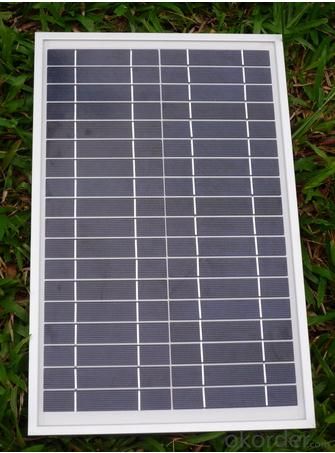
Feature
1.High conversion efficiencies resulting in superior power output performance.
2.Outstanding power output even in low light or high temperature conditions
3.Optimized design for ease of soldering and lamination
Physical characteristic
1. Rigorous quality control meets the highest international standards.
2. High-transmissivity low-iron tempered glass, strong aluminium frame.
3. Using UV-resistant silicon.
4. IS09001/14001/CE/TUV/UL
Packaging
26pcs in one carton 6pallets in 20foot container 14pallets in 40 foot container.
- Q: Can solar energy systems be used for powering electric vehicle solar charging stations at rest areas?
- Solar energy systems can indeed be utilized for the purpose of powering electric vehicle solar charging stations at rest areas. By installing solar panels at these locations, sunlight can be captured and converted into electricity. This generated electricity can then be employed to fuel the charging stations, offering a means for electric vehicles to charge their batteries using clean and renewable energy. This incorporation of solar charging stations presents a noteworthy opportunity to efficiently and sustainably employ solar energy, thus diminishing dependence on fossil fuels and reducing carbon emissions. Furthermore, the integration of energy storage systems, such as batteries, with these charging stations allows for the storage of surplus electricity produced during the day. This stored energy can then be utilized during the night or on cloudy days, ensuring constant availability of charging services even when sunlight is not readily available. Ultimately, the utilization of solar energy systems to power electric vehicle charging stations at rest areas proves to be a solution that is both environmentally friendly and economically feasible.
- Q: How do solar energy systems affect the demand for traditional energy sources?
- Solar energy systems have a significant impact on the demand for traditional energy sources. By harnessing sunlight to generate electricity, solar energy systems reduce the reliance on fossil fuels such as coal, oil, and natural gas. This reduction in demand for traditional energy sources helps to decrease the overall consumption of these finite resources, leading to a more sustainable and environmentally friendly energy sector.
- Q: What is a solar inverter and why is it necessary?
- A solar inverter is a device that converts the direct current (DC) generated by solar panels into alternating current (AC) that can be used to power household appliances and feed electricity back into the grid. It is necessary because most of our electrical devices and the grid operate on AC, while solar panels produce DC. The solar inverter ensures compatibility between the two, maximizing the efficiency and usability of solar energy.
- Q: Can solar energy systems be used in indoor farming or greenhouse applications?
- Yes, solar energy systems can be used in indoor farming or greenhouse applications. Solar panels can be installed on the roofs or walls of greenhouses or indoor farms to harness sunlight and convert it into electricity. This renewable energy source can power various aspects of indoor farming operations, including lighting, heating, ventilation, and irrigation systems. Solar energy systems not only reduce reliance on traditional energy sources but also help in reducing greenhouse gas emissions and overall operating costs for indoor farming or greenhouse applications.
- Q: How much space is needed for a solar energy system?
- The amount of space needed for a solar energy system can vary depending on several factors, including the size of the system and the efficiency of the solar panels. On average, a small residential solar system may require around 100-400 square feet of available roof space, while a larger commercial system could require several thousand square feet or even acres of land. It is important to consider factors such as shading, orientation, and local regulations when determining the space requirements for a solar energy system.
- Q: Are there any risks of electrical grounding issues with solar energy systems?
- Solar energy systems can pose several risks due to electrical grounding issues. One major risk is the potential for electric shock, which occurs when the grounding system is not correctly installed or maintained. This can cause a buildup of electrical current, leading to contact with live electrical components and subsequent shock. Another risk is the possibility of fire. When the grounding system is improperly installed, it can result in electrical arcing, which can ignite a fire. This is especially hazardous as solar energy systems are often situated on rooftops, making it easier for a fire to rapidly spread throughout the entire building. Furthermore, a faulty grounding system can cause damage to the solar energy system itself. Without proper grounding, electrical surges and fluctuations can occur, harming sensitive components like inverters and batteries. To mitigate these risks, it is essential to ensure the proper installation and regular inspection and maintenance of the grounding system in a solar energy system. This involves using appropriate grounding equipment like grounding rods or conductors, as well as ensuring all connections are secure and free from corrosion. Regular testing should also be carried out to assess the effectiveness of the grounding system. It is advisable to enlist the services of a qualified professional for the installation and maintenance of the grounding system to minimize the hazards associated with electrical grounding issues in solar energy systems.
- Q: Can solar energy systems be used for drying agricultural produce?
- Yes, solar energy systems can be effectively used for drying agricultural produce. Solar drying is a sustainable and cost-effective method that harnesses the sun's energy to remove moisture from crops, fruits, vegetables, and other agricultural products. Solar dryers, such as solar air dryers and solar tunnel dryers, provide a controlled environment for drying, ensuring optimal results. This method helps preserve the nutritional value of the produce while minimizing spoilage and post-harvest losses. Additionally, solar drying reduces the reliance on fossil fuels and contributes to a greener and more sustainable agricultural sector.
- Q: How do solar energy systems impact air conditioning costs?
- Solar energy systems can significantly reduce air conditioning costs by providing a renewable and cost-effective source of power. By harnessing the sun's energy to generate electricity, solar panels can power air conditioning units directly, eliminating or reducing the need for grid electricity. This can result in lower energy bills and reduced dependence on fossil fuels, leading to a more sustainable and environmentally-friendly cooling solution.
- Q: Can solar energy systems be used in areas with limited land availability?
- Yes, solar energy systems can be used in areas with limited land availability. There are various types of solar energy systems that can be installed in such areas, including rooftop solar panels, solar parking canopies, and solar walls. These systems utilize the vertical space available and can be integrated into existing structures, making them suitable for areas with limited land availability. Additionally, advancements in solar technology have made it possible to generate more electricity from smaller areas, further increasing the feasibility of solar energy systems in limited land areas.
- Q: How do solar energy systems affect the electrical wiring of a building?
- Solar energy systems can have an impact on the electrical wiring of a building. When solar panels are installed, they need to be connected to the existing electrical system. This typically involves adding a new electrical panel or inverter to convert the DC power from the solar panels to AC power that can be used in the building. Additionally, solar energy systems may require the installation of new wiring to connect the panels to the electrical panel. However, with proper installation and integration, solar energy systems should not negatively affect the electrical wiring of a building.
Send your message to us
110kw CNBM Monocrystalline Silicon Solar Energy Systems Panel for Home Use
- Loading Port:
- Tianjin
- Payment Terms:
- TT OR LC
- Min Order Qty:
- 10 watt
- Supply Capability:
- 1000 watt/month
OKorder Service Pledge
OKorder Financial Service
Similar products
Hot products
Hot Searches
Related keywords
